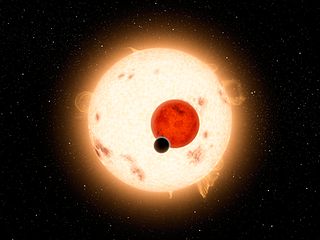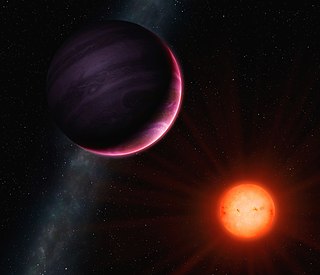Related Research Articles
HD 164922 b is an exoplanet orbiting the star HD 164922 about 72 light-years from Earth in the constellation Hercules. Its inclination is not known, and its true mass may be significantly greater than the radial velocity lower limit of 0.36 Jupiter masses. The planet also has a low eccentricity, unlike most other long period extrasolar planets – 0.05 – about the same as Jupiter and Saturn in the Solar System. The exoplanet was found by using the radial velocity method, from radial-velocity measurements via observation of Doppler shifts in the spectrum of the planet's parent star.

61 Virginis b is an extrasolar planet, orbiting the 5th magnitude G-type star 61 Virginis, in Virgo. This planet has a minimum mass of 5.1 times that of Earth and is an example of a super-Earth planet. It orbits very close to the star, at a distance of 0.050201 AU with an eccentricity of 0.12. This planet was discovered on 14 December 2009 using the radial velocity method taken at Keck and Anglo-Australian Observatories.

An exoplanet is a planet located outside the Solar System. The first evidence of an exoplanet was noted as early as 1917, but was not recognized as such until 2016; no planet discovery has yet come from that evidence. What turned out to be the first detection of an exoplanet was published among a list of possible candidates in 1988, though not confirmed until 2003. The first confirmed detection came in 1992, with the discovery of terrestrial-mass planets orbiting the pulsar PSR B1257+12. The first confirmation of an exoplanet orbiting a main-sequence star was made in 1995, when a giant planet was found in a four-day orbit around the nearby star 51 Pegasi. Some exoplanets have been imaged directly by telescopes, but the vast majority have been detected through indirect methods, such as the transit method and the radial-velocity method. As of 24 July 2024, there are 7,026 confirmed exoplanets in 4,949 planetary systems, with 1007 systems having more than one planet. This is a list of the most notable discoveries.

Kepler-16b is a Saturn-mass exoplanet consisting of half gas and half rock and ice. It orbits a binary star, Kepler-16, with a period of 229 days. "[It] is the first confirmed, unambiguous example of a circumbinary planet – a planet orbiting not one, but two stars," said Josh Carter of the Center for Astrophysics | Harvard & Smithsonian, one of the discovery team.
Kepler-432b (also known by its Kepler Object of Interest designation KOI-1299.01) is a hot super-Jupiter (or "warm" super-Jupiter) exoplanet orbiting the giant star Kepler-432 A, the innermost of two such planets discovered by NASA's Kepler spacecraft. It is located about 2,830 light-years (870 parsecs, or nearly 2.684×1016 km) from Earth in the constellation Cygnus. The exoplanet was found by using the transit method, in which the dimming effect that a planet causes as it crosses in front of its star is measured.

HIP 11915 b is an exoplanet orbiting the solar twin star HIP 11915 about 190 light-years (57 parsecs, or nearly 1.798×1015 km) from Earth in the constellation Cetus. It is notable as the first exoplanet to be discovered with an orbit and mass similar to that of Jupiter (essentially, a "Jupiter analog"), suggesting that its system may be similar to that of the Solar System. It orbits its star at a distance of approximately 4.8 AU. The exoplanet was found by using the radial velocity method, where periodic Doppler shifts of spectral lines of the host star suggest an orbiting object.

K2-3d, also known as EPIC 201367065 d, is a confirmed exoplanet of probable mini-Neptune type orbiting the red dwarf star K2-3, and the outermost of three such planets discovered in the system. It is located 143 light-years away from Earth in the constellation of Leo. The exoplanet was found by using the transit method, in which the dimming effect that a planet causes as it crosses in front of its star is measured. It was the first planet in the Kepler "Second Light" mission to receive the letter "d" designation for a planet. Its discovery was announced in January 2015.
Kepler-419c is a super-Jupiter exoplanet orbiting within the habitable zone of the star Kepler-419, the outermost of two such planets discovered by NASA's Kepler spacecraft. It is located about 3,400 light-years from Earth in the constellation Cygnus. The exoplanet was found by using the transit timing variation method, in which the variations of transit data from an exoplanet are studied to reveal a more distant companion.

Kepler-1647b is a circumbinary exoplanet that orbits the binary star system Kepler-1647, located 3,700 light-years (1,100 pc) from Earth in the constellation Cygnus. It was announced on June 13, 2016, in San Diego at a meeting of the American Astronomical Society. It was detected using the transit method, when it caused the dimming of the primary star, and then again of the secondary star blended with the primary star eclipse. The first transit of the planet was identified in 2012, but at the time the single event was not enough to rule out contamination, or confirm it as a planet. It was discovered by the analysis of the Kepler light-curve, which showed the planet in transit.

K2-33b is a very young super-Neptune exoplanet, orbiting the pre-main-sequence star K2-33. It was discovered by NASA's Kepler space telescope on its "Second Light" mission. It is located about 453 light-years away from Earth in the constellation of Scorpius. The exoplanet was found by using the transit method, in which the dimming effect that a planet causes as it crosses in front of its star is measured.
Kepler-419b is a hot Jupiter exoplanet orbiting the star Kepler-419, the outermost of two such planets discovered by NASA's Kepler spacecraft. It is located about 3,400 light-years (1040 parsecs from Earth in the constellation Cygnus.

WD 1145+017 b, is a confirmed exoasteroid or minor planet orbiting around and being vaporized by the white dwarf star WD 1145+017, likely one of multiple such objects around this star. It was discovered by NASA's Kepler spacecraft on its "Second Light" mission. It is located about 476 light-years away from Earth in the constellation of Virgo. The object was found by using the transit method, in which the dimming effect that a planet causes as it crosses in front of its star is measured.
38 Virginis b is a super-Jupiter exoplanet orbiting within the habitable zone of the star 38 Virginis about 108.5 light-years from Earth in the constellation Virgo. The exoplanet was found by using the radial velocity method, from radial-velocity measurements via observation of Doppler shifts in the spectrum of the planet's parent star.

NGTS-1b is a confirmed hot Jupiter-sized extrasolar planet orbiting NGTS-1, a red dwarf star about half the mass and radius of the Sun, every 2.65 days. The NGTS-1 system is about 716 light-years from Earth in the Columba constellation.
TOI-178c is a potentially rocky planet that orbits the K-type star TOI-178, 204.4783 light-years from Earth. TOI-178c's radius is 1.669 x that of Earth, and its mass is 4.77 that of Earth's, making TOI-178c a super earth. TOI-178c mass was discovered by the radial velocity method with the radius detected by the primary transit method. The orbital radius is 0.037 AU, with an eccentricity of 0.0. A year on TOI-178c is 3.2 days long. TOI-178c was discovered by using the transit method in 2021. TOI-178b, TOI-178d, TOI-178e, TOI-178f, TOI-178g are all in the same system as TOI-178c. The temperature on TOI-178c is 873 Kelvin; the hottest point longitude unknown.
HD 260655 is a relatively bright and cool M0 V red dwarf star located 33 light-years away from the Solar System in the constellation of Gemini. HD 260655 has two confirmed rocky planets, named HD 260655 b and HD 260655 c, that were discovered in 2022. Both planets were detected by the TESS mission and confirmed independently with archival and new precise radial velocity data obtained with the HIRES observatory since 1998, and the CARMENES survey instruments since 2016.

TOI-2180 b is a giant exoplanet orbiting the G-type star TOI-2180, also known as HD 238894. It was discovered with the help of the Transiting Exoplanet Survey Satellite and is currently the exoplanet with the longest orbital period TESS was able to uncover. TOI-2180 b orbits its host star every 260.16 days.
TOI-4342 is a red dwarf star in the constellation Octans located 201 light-years from Earth.
TOI-672 b is a Neptune-like exoplanet, located 218 light-years away. The exoplanet was discovered in the year 2023.
TOI-4603 b is a gas giant exoplanet orbiting HD 245134, a F-type subgiant star located 731 light-years away, in the constellation of Taurus. It orbits its host star at a distance of 0.0888 astronomical units (13,280,000 km), completing one orbit every 7 days around it. With a density of 14.1 g/cm3, it is one of the densest exoplanets known. The planet is just 4% larger than Jupiter, but is 12.9 times more massive, being located in the mass limit between planets and brown dwarfs.
References
- 1 2 3 Hobson, Melissa J.; et al. (2023). "TOI-3235 b: A Transiting Giant Planet around an M4 Dwarf Star". The Astrophysical Journal Letters. 946 (1): L4. arXiv: 2302.10008 . Bibcode:2023ApJ...946L...4H. doi: 10.3847/2041-8213/acbd9a . S2CID 257038386.
- 1 2 "TOI-3235b". Exoplanet Exploration: Planets Beyond our Solar System. Retrieved 2024-01-14.
- 1 2 "The Extrasolar Planet Encyclopaedia — TOI-3235 b". Extrasolar Planets Encyclopaedia . 1995.
- 1 2 "★ TOI 3235". Stellar Catalog. Retrieved 2024-01-14.

